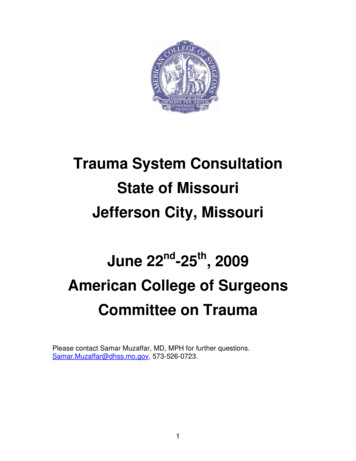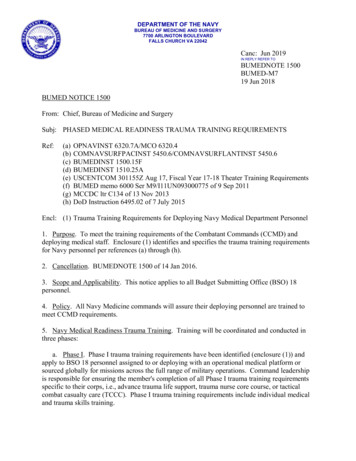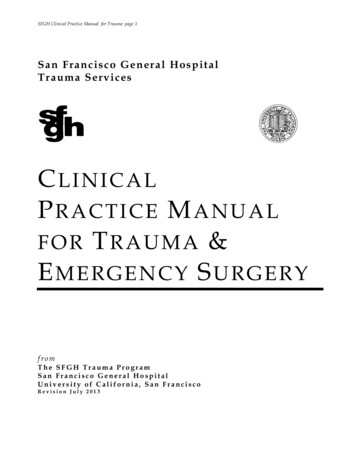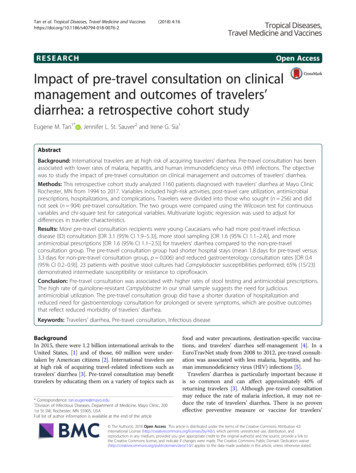
Transcription
Trauma System ConsultationState of MissouriJefferson City, MissouriJune 22nd-25th, 2009American College of SurgeonsCommittee on TraumaPlease contact Samar Muzaffar, MD, MPH for further questions.Samar.Muzaffar@dhss.mo.gov, 573-526-0723.1
A multidisciplinary working group prepared this document based on the consultation visit that took place onndthJune 22 -25 , 2009 in Jefferson City, Missouri and included the following members:Team Leader:Michael F. Rotondo, MD, FACSChair, COT Trauma Systems Evaluation and Planning CommitteeAmerican College of SurgeonsProfessor and Chairman of the Department of SurgeryThe Brody School of Medicine at East Carolina UniversityGreenville, NCTeam:Gail CooperTechnical Advisor TSCAmerican College of SurgeonsPublic Health Administrator - RetiredSan Diego, CAAmy Eberle, RN, BSN, EMTState Trauma CoordinatorNorth Dakota Department of HealthDivision of EMS and TraumaBismarck, NDMark Johnson, MPARetired ChiefCommunity Health and EMS State of AlaskaJuneau, AlaskaMary Sue Jones, RN, MSTrauma System CoordinatorDelaware Office of Emergency Medical ServicesDover, DelawareKathy J. Rinnert, MD, MPHAssociate Professor andAssociate Medical DirectorUniversity of Texas Southwestern at DallasDallas, TXNels D. Sanddal, MS, REMT-B, PhD(c), MSTechnical Advisor TSCPresident, Critical Illness and Trauma FoundationBozeman, MTShelly D. Timmons, MD, FACSNeurological SurgeonSemmes-Murphey ClinicMemphis, TNACS Staff:Holly MichaelsProgram CoordinatorTrauma Systems ConsultationAmerican College of Surgeons2
Table of ContentsExecutive Summary . 5Trauma System Assessment. 10INJURY EPIDEMIOLOGY . 10OPTIMAL ELEMENTS. 11CURRENT STATUS . 12RECOMMENDATIONS. 14INDICATORS AS A TOOL FOR SYSTEM ASSESSMENT . 15OPTIMAL ELEMENT . 15CURRENT STATUS . 15RECOMMENDATIONS. 16Trauma System Policy Development . 17STATUTORY AUTHORITY AND ADMINISTRATIVE RULES . 17OPTIMAL ELEMENTS. 17CURRENT STATUS . 18RECOMMENDATIONS. 20SYSTEM LEADERSHIP . 22OPTIMAL ELEMENTS. 23CURRENT STATUS . 23RECOMMENDATIONS. 26COALITION BUILDING AND COMMUNITY SUPPORT . 28OPTIMAL ELEMENT . 28CURRENT STATUS . 28RECOMMENDATIONS. 29LEAD AGENCY AND HUMAN RESOURCES WITHIN THE LEAD AGENCY . 31OPTIMAL ELEMENTS. 31CURRENT STATUS . 32RECOMMENDATIONS. 33TRAUMA SYSTEM PLAN. 35OPTIMAL ELEMENT . 36CURRENT STATUS . 36RECOMMENDATIONS. 37SYSTEM INTEGRATION . 38OPTIMAL ELEMENTS. 38CURRENT STATUS . 39RECOMMENDATIONS. 42FINANCING . 44OPTIMAL ELEMENTS. 44CURRENT STATUS . 45RECOMMENDATIONS. 46Trauma System Assurance. 47PREVENTION AND OUTREACH . 47OPTIMAL ELEMENTS. 47CURRENT STATUS . 48RECOMMENDATIONS. 49EMERGENCY MEDICAL SERVICES . 51OPTIMAL ELEMENTS. 53CURRENT STATUS . 55RECOMMENDATIONS. 57DEFINITIVE CARE FACILITIES . 58OPTIMAL ELEMENTS. 603
CURRENT STATUS . 61RECOMMENDATIONS. 63SYSTEM COORDINATION AND PATIENT FLOW . 64OPTIMAL ELEMENTS. 65CURRENT STATUS . 66RECOMMENDATIONS. 67REHABILITATION . 68OPTIMAL ELEMENTS. 68CURRENT STATUS . 69RECOMMENDATIONS. 70DISASTER PREPAREDNESS . 71OPTIMAL ELEMENTS. 72CURRENT STATUS . 72RECOMMENDATIONS. 73SYSTEM-WIDE EVALUATION AND QUALITY ASSURANCE . 74OPTIMAL ELEMENTS. 74CURRENT STATUS . 75RECOMMENDATIONS. 76TRAUMA MANAGEMENT INFORMATION SYSTEMS. 77OPTIMAL ELEMENTS. 78CURRENT STATUS . 79RECOMMENDATIONS. 80RESEARCH . 82OPTIMAL ELEMENTS. 84CURRENT STATUS . 85RECOMMENDATIONS. 87Focus Question 1 . 88Focus Question 2 . 90Acronyms Used in the Report. 91Appendix A: Methodology . 93Appendix B: Site Visit Team Biographical Sketches. 95Appendix C: List of Participants . 1014
Executive SummaryOverviewMany states are authorized to establish a trauma system to protect its residentsby statute. Missouri is required to do so not only by statute but by the veryfoundation of the State, its motto: Salus Populi Suprema Lex Esto – Let thewelfare of the people be the supreme law.Missouri is known as the “Show Me” state. It is heterogeneous with a totalpopulation of 5.9 million that has grown about 6% since the last census. About aquarter of the population is under the age of 18 and about 13% are over the ageof 65. Although it has urban centers, it is a rural state with population density of81 people per square mile and about 70,000 square miles. Missouri boasts ahighly diversified economy that includes transportation, beer and beverages,defense, farming, aerospace, lead, zinc, and timber. It is comprised of 114counties which have a number of health care assets including 112 hospitals, 29of which are “trauma centers”, and 36 of which are Critical Access Hospitals(CAH’s). In addition to the acute care facilities, there are 4 rehabilitationhospitals.HistoryIn 2003, Emergency Medical Services (EMS) and trauma care reform was madea priority through a partnership involving the Missouri Foundation for Health(MFH) and the Department of Health and Senior Services (DHSS). The effortwas spearheaded by Dr. Bill Jermyn and the State Advisory Committee on EMS(SAC).In 2004, a “Summit” was convened to garner input from key stakeholders aboutthe design and scope of a new emergency health care program within the DHSS.In 2005, the MFH funded a position for an EMS Medical Director. Dr. Jermynwas, logically, selected to fill that position. A true visionary, Dr. Jermyn movedthe state toward a time critical diagnosis (TCD) concept in which those patientswith immediate life threatening injuries that respond well to specific earlyinterventions would be moved through regional systems of care commensuratewith their needs. The TCD process included stroke, ST elevated myocardialinfarction (STEMI), and trauma. Over the course of the succeeding year, itbecame clear to some that stroke and STEMI were gaining much more tractionthan trauma system development. Dr. Huckfeldt presented data in 2006 thathelped refocus efforts on trauma system development as the leading cause ofdeath of Missourians between ages 1 and 44 with a greater number of years ofproductive life lost than stroke and STEMI combined. In 2008, legislation waspassed that created the TCD System. The State experienced a loss due to theunexpected death of the TCD visionary, Dr. Jermyn in 2008. In spite of thissetback, incremental progress on TCD development continued through writing ofthe report, hiring a new EMS medical director, and supporting the Trauma TaskForce and Stroke/STEMI implementation groups to its current point ofdevelopment.5
Current StatusTrauma stakeholders and DHSS leadership have recognized the need for areinvigoration of efforts to help the trauma system mature and are motivated totake the next steps. There has been measurable progress by the Trauma TaskForce (TTF). Unfortunately, the future status of the TTF is unclear. Clearly, thereare dedicated providers at all levels – state officials, prehospital, hospital,rehabilitation and many others who are anxious to make a renewed commitmentto trauma system development. As such, the ACS Trauma System Consultationwas convened, and the results of this report can and should be used as aroadmap to help focus that renewed commitment.Advantages & Assets The creation of the Trauma Task Force represents a clear and outwardsign of commitment to system development Missouri Foundation for Health has demonstrated steadfast support for theeffort Office of Epidemiology and Health Informatics has committed,enthusiastic, and knowledgeable staff The Injury and Violence Prevention Program has made importantcontributions The Falls Prevention Program is leading edge The rehabilitation capacity is outstanding for a state of its size The overall development approach has been both innovative and creativeby virtue of:o The conceptualization of the TCD Systemo The focus on rural education – Comprehensive Advanced Life Support(CALS)o The integration of CAH’s as Level IV trauma facilitiesChallenges, Vulnerabilities & Opportunities: At the same time, the TCD System represents a potential vulnerability:o There is no clear Mission and Vision for system development relativeto injury careo There has been a loss of focus on injury care relative to the otherelements of the TCD System The current organization and structure lacks integrationo It is unclear whether or not the State Advisory Council on EMS is bothfunctional and efficacious in the cause of advancing trauma systemdevelopment There is lack of data integration and utility6
o Available data is not used for performance improvement or systemevaluationo There is little or no utilization of outside benchmarks for systemperformance While there is a plethora of information on injury epidemiology, little of it iswidely disseminated Statutes related to injury care lack clarity There is fragmentation of the 911 System The designation and licensing cycle is too long and out of sync with bestpractices across the United States The is no dedicated and sustainable fundingPriority Recommendations SummaryThis report contains more than 85 recommendations. The site visit teamidentified the following fourteen as the most important for the trauma system’sshort and long-term success.Statutory Authority and Administrative Rules Revise trauma center designation regulations to adopt, meet, orexceed, by reference, the current version of “Resources for theOptimal Care of the Injured Patient”; Committee on Trauma,American College of Surgeons.System Leadership Create a Division of Emergency Care within the Department of Healthand Senior Services which unifies the Time Critical Diagnosis Systemand Emergency Medical Services. The Division, composed of high levelstate leaders empowered by law, should delineate the vision forMissouri’s trauma system as part of the TCDS.Coalition Building and Community Support Provide workshops on community engagement and coalition building,to further develop and enhance the State’s ability to work effectivelywith constituency groups throughout the state.7
Lead Agency and Human Resources Within the Lead Agency Create and fund a full time dedicated trauma nurse manager positionwithin the lead agency.o The successful candidate should have a strong background intrauma system management and emergency care. Create a DHSS funded leadership position for an EMS/Trauma MedicalDirector (qualified by emergency medicine and trauma experience)within the lead agency.Trauma System Plan Develop a comprehensive strategic plan for the further design,development, implementation, and ongoing improvement of a statewide,integrated, regional based/driven trauma system plan for Missouriwithin the next six months.Financing Develop a specific budget within DHSS to support trauma systemdevelopment and oversight.Definitive Care Facilities Define roles, responsibilities, and accountabilities for all acute carefacilities in an inclusive system related to trauma care. Establish uniform, clearly defined designation criteria, including criticaland non-critical criteria deficiencies for each trauma center level,aligned with the current American College of Surgeons’ guidelines.o Apply criteria consistently to all centers.o Utilize a broader confidential multidisciplinary group (SAC) toreview and act upon designation recommendations.o Eliminate all waivers.o Move to a three year verification schedule in line with nationalstandards.System-wide Evaluation and Quality Assurance Create a consensus vision and plan for Trauma System PerformanceImprovement including:o which forum will be utilized8
o who will be responsible for ito who will participate in ito which filters/parameters will be utilized firsto which data sources will be usedTrauma Management Information System Require all acute care hospitals to participate in the timelysubmission of injury data (limited subset) as part of both traumacenter designation (participating hospitals) and hospital licensure(non-participating acute care facilities). Enforce all EMS agencies to complete and submit a MARScompatible record for all patient contacts. (add to regulatoryauthority as well) Ensure that TCD Data System and MARS data systems are managedin a manner that assures reliability and validity of data and is capableof producing reports that can be used to inform trauma policy. Thiscould occur by either substantially increasing the capacity of thenewly formed Center or by a collaborative relationship with theOffice of Epidemiology and Health Informatics.9
Trauma System AssessmentInjury EpidemiologyPurpose and RationaleInjury epidemiology is concerned with the evaluation of the frequency, rates, andpattern of injury events in a population. Injury pattern refers to the occurrence ofinjury-related events by time, place, and personal characteristics (for example,demographic factors such as age, race, and sex) and behavior andenvironmental exposures, and, thus, it provides a relatively simple form of riskfactor assessment.The descriptive epidemiology of injury among the whole jurisdictional population(geographic area served) within a trauma system should be studied andreported. Injury epidemiology provides the data for public health action andbecomes an important link between injury prevention and control and traumasystem design and development. Within the trauma system, injury epidemiologyhas an integral role in describing the root causes of injury and identifying patternsof injury so that public health policy and programs can be implemented.Knowledge of a region’s injury epidemiology enables the identification of prioritiesfor directing better allocation of resources, the nature and distribution of injuryprevention activities, financing of the system, and health policy initiatives.The epidemiology of injury is obtained by analyzing data from multiple sources.These sources might include vital statistics, hospital administrative dischargedatabases, and data from emergency medical services (EMS), emergencydepartments (EDs), and trauma registries. Motor-vehicle crash data might alsoprove useful, as would data from the criminal justice system focusing oninterpersonal conflict. It is important to assess the burden of injury across specificpopulation groups (for example, children, elderly people and ethnic groups) toensure that specific needs or risk factors are identified. It is critical to assessrates of injury appropriately and, thus, to identify the appropriate denominator (forexample, admissions per 100,000 population). Without such a measure, itbecomes difficult to provide valid comparisons across geographic regions andover time.To establish injury policy and develop an injury prevention and control plan, thetrauma system, in conjunction with the state or regional epidemiologist, shouldcomplete a risk assessment and gap analysis using all available data. Thesedata allow for an assessment of the “injury health” of the population (community,state, or region) and will allow for the assessment of whether injury preventionprograms are available, accessible, effective, and efficient.10
An ongoing part of injury epidemiology is public health surveillance. In the caseof injury surveillance, the trauma system provides routine and systematic datacollection and, along with its partners in public health, uses the data to completeinjury analysis, interpretation, and dissemination of the injury information. Publichealth officials and trauma leaders should use injury surveillance data to describeand monitor injury events and emerging injury trends in their jurisdictions; toidentify emerging threats that will call for a reassessment of priorities and/orreallocation of resources; and to assist in the planning, implementation, andevaluation of public health interventions and programs.OPTIMAL ELEMENTSI. There is a thorough description of the epidemiology of injury in the systemjurisdiction using population-based data and clinical databases. (B-101)a. There is a through description of the epidemiology of injury mortality in thesystem jurisdiction using population-based data. (I-101.1)b. There is a description of injuries within the trauma system jurisdiction,including the distribution by geographic area, high-risk populations(pediatric, elderly, distinct cultural/ethnic, rural, and others), incidence,prevalence, mechanism, manner, intent, mortality, contributing factors,determinants, morbidity, injury severity (including death), and patientdistribution using any or all the following: vital statistics, ED data, EMSdata, hospital discharge data, state police data (data from lawenforcement agencies), medical examiner data, trauma registry, and otherdata sources. The description is updated at regular intervals. (I-101.2)Note: Injury severity should be determined through the consistent andsystem-wide application of one of the existing injury scoring methods, forexample, Injury Severity Score (ISS).c. There is comparison of injury mortality using local, regional, statewide,and national data. (I-101.3)d. Collaboration exists among EMS, public health officials, and traumasystem leaders to complete injury risk assessments. (I-101.4)e. The trauma system works with EMS and public health agencies to identifyspecial at-risk populations. (I-101.7)II. Collected data are used to evaluate system performance and to develop publicpolicy. (B-205)a. Injury prevention programs use trauma management information systemdata to develop intervention strategies. (I-205.4)III. The trauma, public health, and emergency preparedness systems are closelylinked. (B-208)11
a. The trauma system and the public health system have establishedlinkages, including programs with an emphasis on population based publichealth surveillance and evaluation for acute and chronic traumatic injuryand injury prevention. (I-208.1)IV. The jurisdictional lead agency, in cooperation with the other agencies andorganizations, uses analytic tools to monitor the performance of population basedprevention and trauma care services. (B-304)a. The lead agency, along with partner organizations, prepares annualreports on the status on injury prevention and trauma care in the state,regional, or local areas. (I-304.1)b. The trauma system management information system database is availablefor routine public health surveillance. There is concurrent access to thedatabases (ED, trauma, prehospital, medical examiner, and public healthepidemiology) for the purpose of routine surveillance and monitoring ofhealth status that occurs regularly and is a shared responsibility. (I-304.2)CURRENT STATUSMissouri Department of Health and Senior Services (DHSS) has an extremelystrong epidemiology program led by an enthusiastic and committed stateepidemiologist, Dr. Sarah Patrick. Dr. Patrick understands injuries as a keypublic health issue and is eager to support efforts to target injury prevention andcontrol initiatives so as to most effectively address this multifaceted problem.She leads a staff of approximately 100 FTE’s and has a total budget of more than 9 million, much of which comes from federal grants. Her section’s CommunityEducation unit, which has graphic arts and writing expertise, provided graphicsassistance for the Time Critical Diagnosis System report (August 2008) that waswritten by the State EMS Medical Director and consultant. Many site visitattendees were unaware of this rich resource and expressed an interest inworking with Dr. Patrick and her staff to learn more about the epidemiology ofinjury in their locales.Dr. Patrick’s section houses vital records (birth, death, etc) and hospitaldischarge data, including Emergency Department (ED) data, which is mandatedto be reported by all 140 acute care hospitals in the state. ED data and deathdata were used to create the web-based Missouri Information for CommunityAssessment (MICA) program and the Injuries in Missouri report. Participantswere largely unaware of this source of information about injuries in the state andcounties. Local health departments have been educated on the MICA programby Dr. Patrick and her staff, and the MICA website is a public site available foruse by trauma stakeholders.Dr. Patrick has succeeded in securing an EIS (Epidemiologic InvestigationService) officer for Missouri, who will begin work in the near future. She is also12
trying to secure a Centers for Disease Control and Prevention (CDC) Mastersprepared epidemiology officer.The Division of Senior and Disability Programs has written an annual report onfalls among older adults and has identified this mechanism as a major cause ofinjuries in this population.Missouri has multiple significant injury prevention-related federal grants, includingthe CODES (Crash Outcome Data Evaluation System) grant, the CDC TraumaticBrain Injury grant, Public Health and Maternal Child Health block grants, andCDC grants to support sexual assault prevention and forensic examination.These projects are specific to the service requesting the grant and do not appearto be integrated with the trauma system. Dr. Patrick plans to apply for a CDCNational Violent Death Reporting System grant in the future.Dr. Sharmini Rogers is chief of the Bureau of Genetics and Healthy Childrenwithin the Division of Community and Public Health of DHSS. The MissouriInjury and Violence Prevention Advisory Committee (MIVPAC) is also under heraegis. There is one FTE devoted entirely to injury prevention in this section, andthis person uses both national and MICA data to support the activities of theMIVPAC. This coalition addresses injury prevention and control activities formultiple mechanisms of injury and has members from across the state, includingsome trauma centers. They are in the
State of Missouri Jefferson City, Missouri June 22nd-25th, 2009 . Amy Eberle, RN, BSN, EMT State Trauma Coordinator North Dakota Department of Health Division of EMS and Trauma . was spearheaded by Dr. Bill Jermyn and the State Advisory Committee on EMS (SAC). In 2004, a "Summit" was convened to garner input from key stakeholders about .










